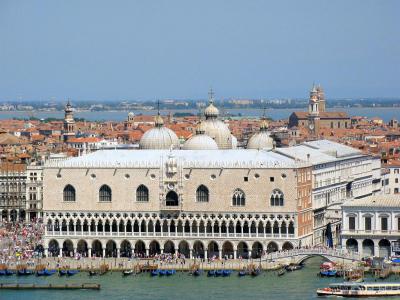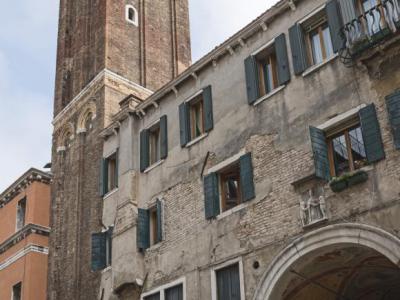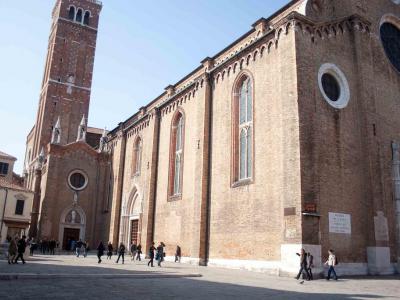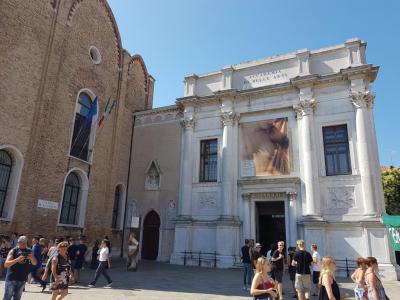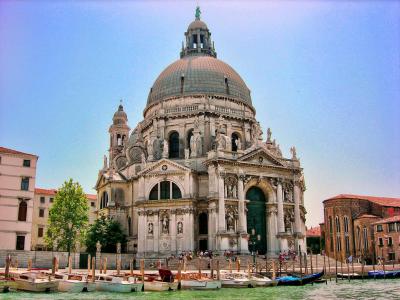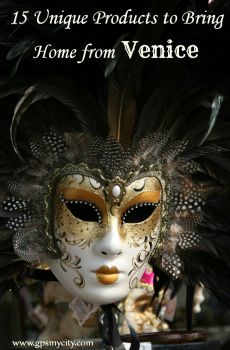
Titian's Paintings Walk (Self Guided), Venice
One of the greatest painters of all time, Tiziano Vecelli – better known as Titian – was a pioneering figure of the Venetian school of Italian Renaissance painting. His career was successful from the start, and he became sought after by patrons, initially from Venice and its possessions, then joined by the north Italian princes, and finally the Habsburgs and papacy.
Equally adept with portraits, landscape backgrounds, and mythological and religious subjects, his methods – particularly in the application and use of colour – exercised a profound influence not only on painters of the late Italian Renaissance, but on future generations of Western art. This self-guided walking tour will guide you through the most important places that have benefited from Titian’s amazing skills.
Because of a devastating fire in the late 16th century, the Doge’s Palace had to be reconstructed – fortunately during the peak of both Venetian wealth and its talents. The result was a massive collaboration among stars like Titian, Veronese, Tintoretto and Tiepolo, who filled every room with paintings and sculptures – some of which are so beautiful that each of them could easily be a headliner piece in any major art museum!
Another veritable treasure-chest of exceptional works of art, Santa Maria Gloriosa dei Frari houses perhaps the most famous masterpiece of Titian's early maturity, “Assumption of the Virgin” (1516-18), as well as the painter's tomb. What’s not to be forgotten is also “Pesaro Madonna” (1526), which some critics thought to be the artist’s best work in Venice.
Other precious works by Titian can be admired in the Gallerie dell'Accademia (“Presentation of the Virgin”), the Santa Maria della Salute (“St. Mark Enthroned”, the altarpiece of the sacristy, as well as ceiling paintings of David and Goliath, Abraham and Isaac and Cain and Abel), and the San Giovanni Elemosinario (“St. John the Almsgiver”).
Take our self-guided walk to admire Titian’s artistic mastership in Venice as well as the beautiful church where he was laid to rest.
Getting to Sight #1. The first tour stop (Palazzo Ducale (Doge's Palace)) is on San Marco Square or can be reached by: Alilaguna Water Taxi: Blue (B), Rosa (R); Water Bus: 1, 2, 4.1, 10, 7, 4.2, 5.2, 2, 20 + N (Night line).
Equally adept with portraits, landscape backgrounds, and mythological and religious subjects, his methods – particularly in the application and use of colour – exercised a profound influence not only on painters of the late Italian Renaissance, but on future generations of Western art. This self-guided walking tour will guide you through the most important places that have benefited from Titian’s amazing skills.
Because of a devastating fire in the late 16th century, the Doge’s Palace had to be reconstructed – fortunately during the peak of both Venetian wealth and its talents. The result was a massive collaboration among stars like Titian, Veronese, Tintoretto and Tiepolo, who filled every room with paintings and sculptures – some of which are so beautiful that each of them could easily be a headliner piece in any major art museum!
Another veritable treasure-chest of exceptional works of art, Santa Maria Gloriosa dei Frari houses perhaps the most famous masterpiece of Titian's early maturity, “Assumption of the Virgin” (1516-18), as well as the painter's tomb. What’s not to be forgotten is also “Pesaro Madonna” (1526), which some critics thought to be the artist’s best work in Venice.
Other precious works by Titian can be admired in the Gallerie dell'Accademia (“Presentation of the Virgin”), the Santa Maria della Salute (“St. Mark Enthroned”, the altarpiece of the sacristy, as well as ceiling paintings of David and Goliath, Abraham and Isaac and Cain and Abel), and the San Giovanni Elemosinario (“St. John the Almsgiver”).
Take our self-guided walk to admire Titian’s artistic mastership in Venice as well as the beautiful church where he was laid to rest.
Getting to Sight #1. The first tour stop (Palazzo Ducale (Doge's Palace)) is on San Marco Square or can be reached by: Alilaguna Water Taxi: Blue (B), Rosa (R); Water Bus: 1, 2, 4.1, 10, 7, 4.2, 5.2, 2, 20 + N (Night line).
How it works: Download the app "GPSmyCity: Walks in 1K+ Cities" from Apple App Store or Google Play Store to your mobile phone or tablet. The app turns your mobile device into a personal tour guide and its built-in GPS navigation functions guide you from one tour stop to next. The app works offline, so no data plan is needed when traveling abroad.
Titian's Paintings Walk Map
Guide Name: Titian's Paintings Walk
Guide Location: Italy » Venice (See other walking tours in Venice)
Guide Type: Self-guided Walking Tour (Sightseeing)
# of Attractions: 5
Tour Duration: 2 Hour(s)
Travel Distance: 3.6 Km or 2.2 Miles
Author: naomi
Sight(s) Featured in This Guide:
Guide Location: Italy » Venice (See other walking tours in Venice)
Guide Type: Self-guided Walking Tour (Sightseeing)
# of Attractions: 5
Tour Duration: 2 Hour(s)
Travel Distance: 3.6 Km or 2.2 Miles
Author: naomi
Sight(s) Featured in This Guide:
- Palazzo Ducale (Doge's Palace)
- Chiesa di San Giovanni Elemosinario (Church of St. John the Almsgiver)
- Basilica di Santa Maria Gloriosa dei Frari (Basilica of Glorious St. Mary of the Friars)
- Gallerie dell'Accademia (Gallery of the Academy)
- Basilica di Santa Maria della Salute (Basilica of Our Lady of Good Health)
1) Palazzo Ducale (Doge's Palace) (must see)
Built on the foundations of a 9th-century fortress, this palace is unquestionably the finest secular European building of its time. Over the course of centuries, it has served many purposes, including Doge residence, seat of the Venetian government, court of law, civil office, and even a prison.
First built in the 14th century, much of the edifice was destroyed by fire in the 16th century, reducing to ashes most of the art treasures held inside. Some of the greatest Venetian masters of the time, such as Tintoretto, Veronese, Titian, Bellini, and Tiepolo, contributed to the restoration efforts, recreating gilded stucco, sculptures, frescoes, and canvases that returned the palace to its former glory.
Externally, the palace exhibits a blend of Byzantine and Gothic architectural styles, while the interior exudes Classical elements, leading art critic John Ruskin to proclaim it "the central building of the world". Inside, visitors are treated to a lavish display of furnishings, paintings, and elaborately adorned ceilings. Of notable grandeur is the Grand Council chamber, featuring Tintoretto's monumental "Paradise", reputedly the largest oil painting in the world. Equally magnificent is the Sala dello Scrutinio, or "Voting Hall," adorned with paintings depicting Venice's glorious past.
In stark contrast, the opposite side of the canal reveals the grim remnants of medieval justice—the prison cells. Linked to the outside world by the Bridge of Sighs ("Ponte dei Sospiri"), these cells serve as a haunting reminder of the horrors endured by prisoners who faced torture and potential death at the hands of the city's appointed state inquisitors. The term "sighs" refers to the lamentations of countless victims forced across the bridge.
To get the most of your time at the Doge's Palace, consider using the infrared audio guide available at the entrance, which provides a captivating narrative of the 1,000-year-old maritime republic of Venice and the intricacies of its former government.
***CASANOVA TOUR***
At the age of 30, on the fateful night of 25 July 1755, Casanova found himself arrested, accused of offending religion and common decency. Shockingly, he was sentenced to five years of imprisonment without even being granted a trial. His confinement took place in the Doge's Palace, where he was confined to a cell beneath the lead-covered roof. In the sweltering summer months, the oppressive heat turned his place of incarceration into an unbearable oven, further exacerbated by the torment of countless fleas infesting the premises.
Physically, Casanova was not far from the opulence of Venice and the seat of power, yet the psychological distance between his confinement and the world outside was immeasurable. Enduring 15 months of torment and despair, he finally hatched a daring plan to escape. Creating a hole in the ceiling, he ingeniously fashioned ropes from bed sheets and descended to freedom. This remarkable escape made Casanova the only person ever to break free from the prison of the Doge's Palace. Seeking sanctuary, he first sought refuge in Munich, then continued his journey to Strasbourg, eventually concluding his odyssey by coach to Paris, where he would start a new life.
Tip:
Make sure to book in advance for the guided "Secret Itinerary" tour – an exclusive experience grants access to otherwise restricted quarters and hidden passageways, including the Doge's private chambers, the interrogation rooms where prisoners were questioned, and the two cells once occupied by Casanova.
First built in the 14th century, much of the edifice was destroyed by fire in the 16th century, reducing to ashes most of the art treasures held inside. Some of the greatest Venetian masters of the time, such as Tintoretto, Veronese, Titian, Bellini, and Tiepolo, contributed to the restoration efforts, recreating gilded stucco, sculptures, frescoes, and canvases that returned the palace to its former glory.
Externally, the palace exhibits a blend of Byzantine and Gothic architectural styles, while the interior exudes Classical elements, leading art critic John Ruskin to proclaim it "the central building of the world". Inside, visitors are treated to a lavish display of furnishings, paintings, and elaborately adorned ceilings. Of notable grandeur is the Grand Council chamber, featuring Tintoretto's monumental "Paradise", reputedly the largest oil painting in the world. Equally magnificent is the Sala dello Scrutinio, or "Voting Hall," adorned with paintings depicting Venice's glorious past.
In stark contrast, the opposite side of the canal reveals the grim remnants of medieval justice—the prison cells. Linked to the outside world by the Bridge of Sighs ("Ponte dei Sospiri"), these cells serve as a haunting reminder of the horrors endured by prisoners who faced torture and potential death at the hands of the city's appointed state inquisitors. The term "sighs" refers to the lamentations of countless victims forced across the bridge.
To get the most of your time at the Doge's Palace, consider using the infrared audio guide available at the entrance, which provides a captivating narrative of the 1,000-year-old maritime republic of Venice and the intricacies of its former government.
***CASANOVA TOUR***
At the age of 30, on the fateful night of 25 July 1755, Casanova found himself arrested, accused of offending religion and common decency. Shockingly, he was sentenced to five years of imprisonment without even being granted a trial. His confinement took place in the Doge's Palace, where he was confined to a cell beneath the lead-covered roof. In the sweltering summer months, the oppressive heat turned his place of incarceration into an unbearable oven, further exacerbated by the torment of countless fleas infesting the premises.
Physically, Casanova was not far from the opulence of Venice and the seat of power, yet the psychological distance between his confinement and the world outside was immeasurable. Enduring 15 months of torment and despair, he finally hatched a daring plan to escape. Creating a hole in the ceiling, he ingeniously fashioned ropes from bed sheets and descended to freedom. This remarkable escape made Casanova the only person ever to break free from the prison of the Doge's Palace. Seeking sanctuary, he first sought refuge in Munich, then continued his journey to Strasbourg, eventually concluding his odyssey by coach to Paris, where he would start a new life.
Tip:
Make sure to book in advance for the guided "Secret Itinerary" tour – an exclusive experience grants access to otherwise restricted quarters and hidden passageways, including the Doge's private chambers, the interrogation rooms where prisoners were questioned, and the two cells once occupied by Casanova.
2) Chiesa di San Giovanni Elemosinario (Church of St. John the Almsgiver)
The Church of Saint John the Almsgiver is tightly squeezed among the surrounding buildings, with its 15th-century bell tower being the only prominent sign of its existence. Originally established in the 11th century, it suffered severe damage during the massive fire of 1514. Only the bell tower survived, and after the church was reconstructed between 1527 and 1529 according to designs by Scarpagnino, a bell was rung every evening as a signal for all fires to be extinguished for the night.
The majority of the church's ornamentation dates back to the decades following its reconstruction. It houses several paintings by the prolific Palma il Giovane, as well as artworks by Leonardo Corona. However, the most notable pieces are the high altarpiece by Titian titled "Saint John the Almsgiver," depicting the 7th-century Patriarch of Alexandria, and Pordenone's nearby painting "Saints Catherine, Sebastian, and Roch". The latter portrays a robust and monumental San Sebastiano, with his nearly naked figure exuding strength, a vibrant and absorbed Santa Caterina gazing skyward, and a spontaneous San Rocco displaying a healed leg, symbolizing his recovery from the bubonic plague. Additionally, the cupola features frescoes by Pordenone, showcasing a group of cherubs with robust figures.
The majority of the church's ornamentation dates back to the decades following its reconstruction. It houses several paintings by the prolific Palma il Giovane, as well as artworks by Leonardo Corona. However, the most notable pieces are the high altarpiece by Titian titled "Saint John the Almsgiver," depicting the 7th-century Patriarch of Alexandria, and Pordenone's nearby painting "Saints Catherine, Sebastian, and Roch". The latter portrays a robust and monumental San Sebastiano, with his nearly naked figure exuding strength, a vibrant and absorbed Santa Caterina gazing skyward, and a spontaneous San Rocco displaying a healed leg, symbolizing his recovery from the bubonic plague. Additionally, the cupola features frescoes by Pordenone, showcasing a group of cherubs with robust figures.
3) Basilica di Santa Maria Gloriosa dei Frari (Basilica of Glorious St. Mary of the Friars) (must see)
The Frari Basilica, located slightly off the beaten path, is perhaps the second most notable church to visit in Venice after Saint Mark's Basilica ("Basilica di San Marco"). Situated in a charming area with a great deal of character, it is rarely, if ever, assailed by visitors. However, the building itself is extraordinary and stands as a true monument to Venetian history and art.
Founded by the Franciscan order in the late 13th century, this gargantuan edifice is one of Venice's largest, with its brick bell tower being the second tallest after Saint Mark's. It is also one of the three Venetian churches to retain a Gothic appearance – rather plain on the outside, including the facade. Despite its deceptively unassuming "mountain of brick" exterior, the interior is truly astonishing.
Few buildings in Venice can rival the Frari in terms of housing multiple first-rate works by Titian. The renowned "Assumption" painting, unprecedented at the time, soars over the high altar. Another masterpiece by Titian displayed here is the "Madonna di Ca' Pésaro" – equally innovative in the placement of Virgin Mary's figure away from the center of the composition.
Alongside these and other paintings by Vivarini and Bellini, the church is also adorned with Donatello's wooden statue of Saint John the Baptist, a beautiful 15th-century choir, and an abundance of extravagant tombs. On the right-hand side of the nave, you'll find a 19th-century monument marking the grave of Titian. The esteemed artist passed away in 1576, aged nearly 90, due to the plague. Such was his high regard that Titian was the only plague victim allowed a church burial during the outbreak. On the opposite side, there is a marble pyramid – the mausoleum of sculptor Antonio Canova, erected by his students – and a rather controversial, if not grotesque, tomb of Doge Giovanni Pésaro, a monumental composition supported by gigantic Moors and featuring decomposing bodies among other figures.
To delve deeper into the artworks, consider picking up a guidebook or a free pamphlet by the ticket office as an aid.
Tip:
Please dress modestly (covers provided).
Founded by the Franciscan order in the late 13th century, this gargantuan edifice is one of Venice's largest, with its brick bell tower being the second tallest after Saint Mark's. It is also one of the three Venetian churches to retain a Gothic appearance – rather plain on the outside, including the facade. Despite its deceptively unassuming "mountain of brick" exterior, the interior is truly astonishing.
Few buildings in Venice can rival the Frari in terms of housing multiple first-rate works by Titian. The renowned "Assumption" painting, unprecedented at the time, soars over the high altar. Another masterpiece by Titian displayed here is the "Madonna di Ca' Pésaro" – equally innovative in the placement of Virgin Mary's figure away from the center of the composition.
Alongside these and other paintings by Vivarini and Bellini, the church is also adorned with Donatello's wooden statue of Saint John the Baptist, a beautiful 15th-century choir, and an abundance of extravagant tombs. On the right-hand side of the nave, you'll find a 19th-century monument marking the grave of Titian. The esteemed artist passed away in 1576, aged nearly 90, due to the plague. Such was his high regard that Titian was the only plague victim allowed a church burial during the outbreak. On the opposite side, there is a marble pyramid – the mausoleum of sculptor Antonio Canova, erected by his students – and a rather controversial, if not grotesque, tomb of Doge Giovanni Pésaro, a monumental composition supported by gigantic Moors and featuring decomposing bodies among other figures.
To delve deeper into the artworks, consider picking up a guidebook or a free pamphlet by the ticket office as an aid.
Tip:
Please dress modestly (covers provided).
4) Gallerie dell'Accademia (Gallery of the Academy)
Experience the enduring splendor of Venice through the expansive collection of paintings housed in the renowned Academy ("Accademia"). This remarkable gallery showcases artworks from the Middle Ages to the Renaissance, representing the vibrant Venetian painting school known for its exuberant use of color. Within its walls, masterpieces by Venice's glorious sons – from Veronese to Titian to Tintoretto – come to life.
Among other highlights, you'll discover the works of 14th-century maestros Paolo and Lorenzo Veneziano, who bridged the gap between Byzantine and Gothic art. Giovanni Bellini, the creator of the captivating paintings "Madonna and Saint" and "Madonnas and Bambini", also commands attention. Vittore Carpaccio's evocative depictions of mass crucifixion and narrative scenes of Saint Ursula offer a mesmerizing glimpse into the domestic architecture, costumes, and decorative arts of late 15th-century Venice, while Giorgione's iconic painting "The Tempest", featuring a nursing baby overlooked by a man with a staff, adds to the gallery's allure.
Rooms 6 to 8 pay homage to the heavyweight figures of the Venetian High Renaissance, such as Tintoretto, Titian, Veronese, and Lotto. While these works would enrich any art collection worldwide, they serve as mere "appetizers" compared to the grandeur awaiting visitors in the vast Room #10. Within this space, a single canvas named "Christ in the House of Levi" by Paolo Veronese dominates an entire wall, leaving spectators awestruck.
As you conclude your visit, don't miss the opportunity to behold Titian's "Presentation of the Virgin" – a fitting farewell to the pantheon of esteemed Venetian artists.
Why You Should Visit:
Large, spacious and clean; the rooms are well planned and the layout beautiful.
Tip:
The entry fee for the gallery is reasonable, and during major local festivals, admission may even be free. Additionally, if you purchase a ticket, take note that it grants you access to the recently renovated Grimani Palace, conveniently located just a short walk away.
Among other highlights, you'll discover the works of 14th-century maestros Paolo and Lorenzo Veneziano, who bridged the gap between Byzantine and Gothic art. Giovanni Bellini, the creator of the captivating paintings "Madonna and Saint" and "Madonnas and Bambini", also commands attention. Vittore Carpaccio's evocative depictions of mass crucifixion and narrative scenes of Saint Ursula offer a mesmerizing glimpse into the domestic architecture, costumes, and decorative arts of late 15th-century Venice, while Giorgione's iconic painting "The Tempest", featuring a nursing baby overlooked by a man with a staff, adds to the gallery's allure.
Rooms 6 to 8 pay homage to the heavyweight figures of the Venetian High Renaissance, such as Tintoretto, Titian, Veronese, and Lotto. While these works would enrich any art collection worldwide, they serve as mere "appetizers" compared to the grandeur awaiting visitors in the vast Room #10. Within this space, a single canvas named "Christ in the House of Levi" by Paolo Veronese dominates an entire wall, leaving spectators awestruck.
As you conclude your visit, don't miss the opportunity to behold Titian's "Presentation of the Virgin" – a fitting farewell to the pantheon of esteemed Venetian artists.
Why You Should Visit:
Large, spacious and clean; the rooms are well planned and the layout beautiful.
Tip:
The entry fee for the gallery is reasonable, and during major local festivals, admission may even be free. Additionally, if you purchase a ticket, take note that it grants you access to the recently renovated Grimani Palace, conveniently located just a short walk away.
5) Basilica di Santa Maria della Salute (Basilica of Our Lady of Good Health) (must see)
While San Marco may hold the title of Venice's most famous church in name, it is Santa Maria della Salute that claims the city's most iconic image and silhouette. Affectionately known as La Salute, this grand historical church is largely recognized as the pinnacle of the city's Baroque movement.
La Salute is the youngest among the so-called "plague churches". Back in the early 1630s, Venice was ravaged by a plague that claimed the lives of nearly 100,000 people, roughly one-third of the lagoon's population. In gratitude for deliverance from this calamity, the Republic of Venice made a vow to construct and dedicate a church to Our Lady of Good Health (or Deliverance), hence the name "Salute" in Italian. Resting on a foundation of over 100,000 wooden piles, the church was designed in the fashionable Baroque style of the time by Baldassare Longhena, who devoted half a century to this grand project and lived long enough to witness its completion in 1681.
The dome of La Salute became an important addition to the Venetian skyline and soon became emblematic of the city, inspiring painters both local, such as Canaletto and Francesco Guardi, and foreign, such as J. M. W. Turner, Claude Monet and John Singer Sargent.
The basilica itself offers an intriguing visit. Its sacristy houses a small art gallery featuring notable works such as Tintoretto's "Marriage Feast of Cana" and allegorical ceiling paintings by Titian, the eminent figure of the 16th-century Venetian school. These include masterpieces like "David and Goliath", "Abraham and Isaac", "Cain and Abel", as well as eight circular paintings depicting the "Doctors of the Church and the Evangelists". Also by Titian are "The Descent of the Holy Ghost", located in the third altar to the left of the entrance, and the altarpiece of the sacristy portraying "Saint Mark Enthroned with Saints Cosmas, Damian, Sebastian, and Roch."
A highly symbolic statuary group called "The Queen of Heaven expelling the Plague" (1670) by the Flemish sculptor Josse de Corte stands out at the high altar. This theatrical Baroque masterpiece depicts the Virgin (portrayed as a kneeling young woman) and Child rescuing Venice from the clutches of the plague (portrayed as an old woman).
Entrance to the Basilica is always free during the opening hours, although a ticket is required to enter the main sacristy (museum). It is advisable to secure your tickets in advance to avoid long queues. Once inside, you can indulge in a unique view of the adjoining square from the balcony and, if fortunate, attend a 30-minute organ recital following the service. Be sure to check the events program in advance for schedules and enjoy this special experience.
Tip:
As there are limited cafes in the vicinity, it is advisable to bring a drink with you during your visit.
La Salute is the youngest among the so-called "plague churches". Back in the early 1630s, Venice was ravaged by a plague that claimed the lives of nearly 100,000 people, roughly one-third of the lagoon's population. In gratitude for deliverance from this calamity, the Republic of Venice made a vow to construct and dedicate a church to Our Lady of Good Health (or Deliverance), hence the name "Salute" in Italian. Resting on a foundation of over 100,000 wooden piles, the church was designed in the fashionable Baroque style of the time by Baldassare Longhena, who devoted half a century to this grand project and lived long enough to witness its completion in 1681.
The dome of La Salute became an important addition to the Venetian skyline and soon became emblematic of the city, inspiring painters both local, such as Canaletto and Francesco Guardi, and foreign, such as J. M. W. Turner, Claude Monet and John Singer Sargent.
The basilica itself offers an intriguing visit. Its sacristy houses a small art gallery featuring notable works such as Tintoretto's "Marriage Feast of Cana" and allegorical ceiling paintings by Titian, the eminent figure of the 16th-century Venetian school. These include masterpieces like "David and Goliath", "Abraham and Isaac", "Cain and Abel", as well as eight circular paintings depicting the "Doctors of the Church and the Evangelists". Also by Titian are "The Descent of the Holy Ghost", located in the third altar to the left of the entrance, and the altarpiece of the sacristy portraying "Saint Mark Enthroned with Saints Cosmas, Damian, Sebastian, and Roch."
A highly symbolic statuary group called "The Queen of Heaven expelling the Plague" (1670) by the Flemish sculptor Josse de Corte stands out at the high altar. This theatrical Baroque masterpiece depicts the Virgin (portrayed as a kneeling young woman) and Child rescuing Venice from the clutches of the plague (portrayed as an old woman).
Entrance to the Basilica is always free during the opening hours, although a ticket is required to enter the main sacristy (museum). It is advisable to secure your tickets in advance to avoid long queues. Once inside, you can indulge in a unique view of the adjoining square from the balcony and, if fortunate, attend a 30-minute organ recital following the service. Be sure to check the events program in advance for schedules and enjoy this special experience.
Tip:
As there are limited cafes in the vicinity, it is advisable to bring a drink with you during your visit.
Walking Tours in Venice, Italy
Create Your Own Walk in Venice
Creating your own self-guided walk in Venice is easy and fun. Choose the city attractions that you want to see and a walk route map will be created just for you. You can even set your hotel as the start point of the walk.
Piazza San Marco Walking Tour
All of Venice’s roads seem to run into Piazza San Marco – the commercial, religious, and political heart of the city. With a glowing reputation as one of the finest squares in the world and arguably one of Europe’s primary tourist attractions, it certainly has a lot to offer to visitors.
Start your exploration with a tour of the pink-and-white marble Palazzo Ducale, which takes you... view more
Tour Duration: 1 Hour(s)
Travel Distance: 0.6 Km or 0.4 Miles
Start your exploration with a tour of the pink-and-white marble Palazzo Ducale, which takes you... view more
Tour Duration: 1 Hour(s)
Travel Distance: 0.6 Km or 0.4 Miles
Venice's Hidden Art Treasures
Among the first things springing to mind when talking about Venice, apart from the canals and gondolas, of course, is Art and Architecture. Indeed, Venice is one of the few cities in the world where Art and Architecture have merged in a stunning multiplicity of forms. The city is even renowned for its unique (Venetian) pictorial school famed by the likes of Tintoretto, Titian, Veronese, Castagno... view more
Tour Duration: 2 Hour(s)
Travel Distance: 3.6 Km or 2.2 Miles
Tour Duration: 2 Hour(s)
Travel Distance: 3.6 Km or 2.2 Miles
Murano Island Walking Tour
Murano is often called the Glass Island, since it is home to the most impressive and renowned Venetian glass factories. The master craftsmen here have preserved their centuries-old techniques, and the island is full of shops where you can admire and purchase their adorable glass items. Some factories, such as Gino Mazzuccato’s, at the start of this self-guided walk, even have special showrooms... view more
Tour Duration: 1 Hour(s)
Travel Distance: 2.3 Km or 1.4 Miles
Tour Duration: 1 Hour(s)
Travel Distance: 2.3 Km or 1.4 Miles
Casanova's Venice
One of Venice's most famous personalities, Giacomo Casanova is remembered today as a womanizer, but was much more than that. Born in a family of theater actors in 1725, he came through as highly intellectual and very sharp from his very childhood, having become in his time an erudite scholar, a diplomat and spy, and a metropolitan ‘avant la lettre’, who frequented the high society and... view more
Tour Duration: 2 Hour(s)
Travel Distance: 4.5 Km or 2.8 Miles
Tour Duration: 2 Hour(s)
Travel Distance: 4.5 Km or 2.8 Miles
Jewish Ghetto Tour
Founded in 1516, the Jewish Ghetto in Venice was the oldest of its kind in all Europe. At the time, Venice received order from the Pope to expel all Jews from the city, but the Venetian government opted to lock them onto a small island in the district of Cannaregio. Since then this small area has been the center of Jewish life in Venice, with buildings rising vertically to accommodate the rising... view more
Tour Duration: 1 Hour(s)
Travel Distance: 0.4 Km or 0.2 Miles
Tour Duration: 1 Hour(s)
Travel Distance: 0.4 Km or 0.2 Miles
Venice Introduction Walking Tour
Although most experts agree that the Venetian lagoon emerged nearly 6,000 years ago, the area of today's Venice remained mostly uninhabited, except for a small population of fishermen, up until the 5th century AD when the hordes of Gothic barbarians, looting their way into Rome, drove many a people away from their homes on the mainland to take refuge on the coastal Venetian islands.
Those... view more
Tour Duration: 3 Hour(s)
Travel Distance: 4.1 Km or 2.5 Miles
Those... view more
Tour Duration: 3 Hour(s)
Travel Distance: 4.1 Km or 2.5 Miles
Useful Travel Guides for Planning Your Trip
15 Distinctively Italian Things to Buy in Venice
Venice has been a tourist mecca for over a century now, with millions of visitors flocking in every year to see this unique place on the face of the Earth. Many, if not all, of these people seek to obtain something memorable as a token of their stay in this city. By far, not all of them know which...
The Most Popular Cities
/ view all
